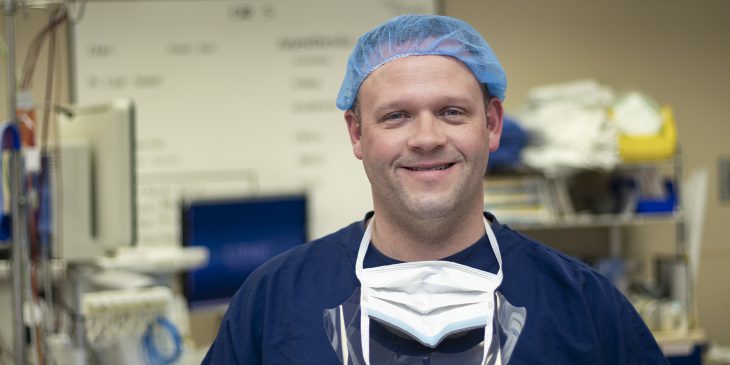Growing up, Brett Fadgen, nurse anesthetist, Physician Services Division, always wanted to prove that he could do anything, but knew he’d have to figure it out on his own.
Brett is like any other nurse anesthetist at UPMC, except that he’s part of a 12-person team that’s credentialed to work at any UPMC facility on any given day — and was born without a right arm.
Over the course of his career, he’s been a firefighter, a paramedic, a rescue specialist, and a flight nurse with STAT MedEvac — and still he wanted more. So, he applied to the Nurse Anesthesia program at the University of Pittsburgh.
In the first simulation workshop, students were to perform endotracheal intubation. Brett did not pass at first. His results were the same as his classmates’, but he hadn’t used the standard technique. “I have to learn how to do things differently. I didn’t like to label myself with the term ‘disability’ because I viewed it as saying I was disabled.”
The director of University of Pittsburgh’s Nurse Anesthesia program pointed him to the office of Disability Services where he learned that having a disability does not mean he was disabled. He then declared he had a disability. By doing so, he was able to develop adaptive devices and implement them in simulation labs and clinical practice as a reasonable accommodation so that he could safely — and successfully — perform his job while being the only documented nurse anesthetist in the world with one arm.
“A person with a disability can navigate the health care system and beat the odds,” said Brett, who is now a member of the UPMC ENABLED (Empowering Abilities and Leveraging Differences) Network.
It’s about perspective and creating an opportunity for success. While Brett’s daily life is impacted by something we can easily see, it is important to remember that not all disabilities are visible.
“A lot of people who do not have a disability struggle to understand how something can or cannot be done by a person with a disability … Someone who’s 6’5″ might be able to see across the room and see the exit sign at a store, but someone who’s 4’8″ might not be able to find an exit.”
To hear more of Brett’s story, check out the Life Changing Moments podcast. This weekly podcast is available now on iTunes, Spotify, and Google Play.








